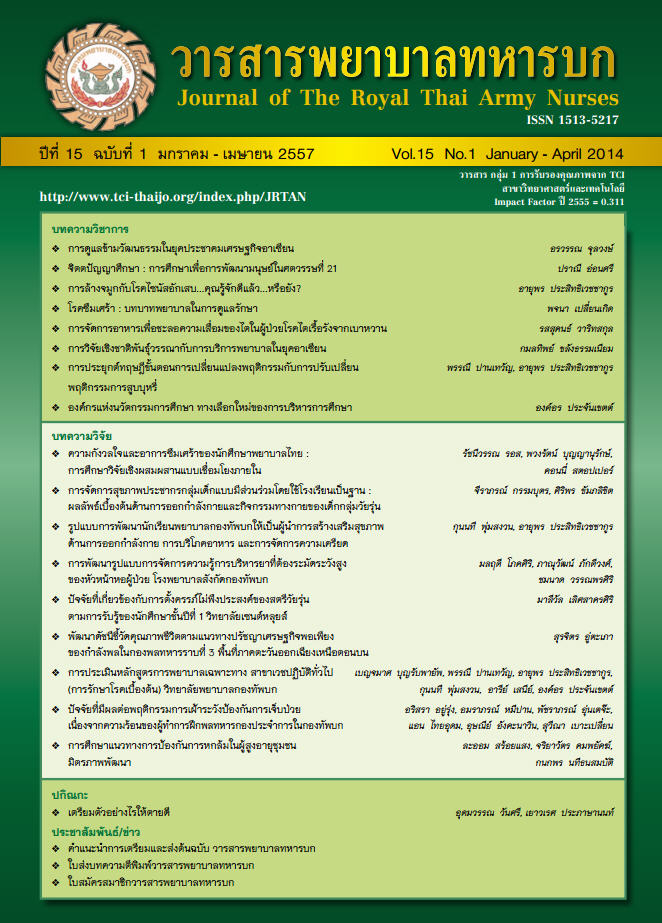การจัดการสุขภาพประชากรกลุ่มเด็กแบบมีส่วนร่วมโดยใช้โรงเรียนเป็นฐาน:ผลลัพธ์เบื้องต้นด้านการออกกำลังกายและกิจกรรมทางกายของเด็กกลุ่มวัยรุ่น The school-based participative health management in children:The preliminary outcomes on exercise and physical activity
Keywords:
การจัดการสุขภาพแบบมีส่วนร่วม, การออกกำลังกายและกิจกรรมทางกาย, วัยรุ่น, Participative health management, Exercise and physical activity, AdolescentAbstract
ในปัจจุบัน กลุ่มประชากรวัยเด็กและวัยรุ่นมีลักษณะการดำเนินชีวิตประจำวันที่เป็นแบบมีกิจกรรมที่ใช้พลังงานน้อยประกอบกับกิจกรรมดังกล่าวนี้มักต่อเนื่องไปจนถึงวัยผู้ใหญ่ซึ่งเป็นปัจจัยเสี่ยงที่ทำให้เกิดโรคเรื้อรังในวัยผู้ใหญ่หรือวัยสูงอายุ การวิจัยเชิงคุณภาพโดยใช้แนวทางการจัดการสุขภาพแบบให้ชุมชนมีส่วนร่วมโดยใช้โรงเรียนเป็นฐานฉบับนี้ใช้กระบวนการ PDCA เพื่อทราบความต้องการ กิจกรรมทางกาย และการออกกำลังกายของวัยรุ่น และแนวทางการจัดการเพื่อสนับสนุนการออกกำลังกายในวัยรุ่นอย่างครอบคลุมชัดเจน การเก็บรวบรวมข้อมูลใช้การประชุมกลุ่มและการระดมสมองกิจกรรมการมีส่วนร่วม การสัมภาษณ์แบบกึ่งมีโครงสร้าง การสังเกตอย่างมีส่วนร่วมและการจดบันทึก กลุ่มตัวอย่างประกอบด้วยผู้แทนนักเรียน 6 คน และคณะกรรมการเพื่อการออกกำลังกายของโรงเรียนที่ประกอบด้วยครู 6 คน และผู้นำนักเรียน 6 คน การวิเคราะห์ข้อมูลเชิงคุณภาพใช้วิธีการวิเคราะห์เนื้อหา นอกจากนี้ความน่าเชื่อถือได้ (Trustworthiness) ในกระบวนการดำเนินการและการประเมินผลอย่างมีประสิทธิภาพในงานวิจัยเชิงคุณภาพถูกดำเนินการร่วมด้วยเพื่อความสมบูรณ์ของการเนื้อหา ข้อมูลและการจัดการสุขภาพ
สี่วงรอบ PDCA ถูกดำเนินการในช่วงเวลา 18 เดือน เพื่อดำเนินการจัดการสุขภาพกลุ่มวัยรุ่นแบบมีส่วนร่วมโดยใช้โรงเรียนเป็นฐานอย่างมีประสิทธิภาพ ซึ่งปรากฏผลลัพธ์และการเปลี่ยนแปลงใน 3 ประเด็นดังนี้ (1) ประเด็นปัญหาและการออกกำลังกาย พบว่า วัยรุ่นชอบออกกำลังกายที่บ้าน และไม่ชอบออกกำลังกายที่โรงเรียนเนื่องจากข้อจำกัดในเรื่องเวลา อากาศร้อน สถานที่ไม่เพียงพอและมีเหงื่อ เหนื่อย และกลิ่นตัวหลังจากออกกำลังกาย ส่วนข้อดีคือ ทำให้รูปร่างสวยงาม สุขภาพดี และให้ความสนุก (2) ประเด็นความต้องการของวัยรุ่นพบว่า วัยรุ่นต้องการให้โรงเรียนมีอุปกรณ์กีฬา สถานที่ที่ให้ร่มเงาการฝึกฝนกิจกรรมกีฬาและการออกกำลังกาย วัน/ชั่วโมงกีฬา และการสนับสนุนจากครอบครัว (3) ประเด็นการจัดการสุขภาพพบว่ามีการเปลี่ยนแปลงดังนี้ (3.1) ระดับบุคคลมีการออกกำลังตอนเช้า การฝึกฝนการออกกำลังกายเพื่อสุขภาพ และสนับสนุนอุปกรณ์การกีฬา (3.2) ระดับครอบครัว ข้อมูลต่างๆ ข้างต้นประสานสู่ครอบครัวเพื่อสนับสนุนการออกกำลังกายที่บ้าน (3.3) ระดับโรงเรียน การพัฒนาสิ่งแวดล้อมให้เอื้อต่อการออกกำลังกายถูกยกเป็นนโยบายระดับโรงเรียน
Recently, children and adolescent are often sedentary in daily life, associated with the age-related declines in physical activity from childhood to adolescence, increases the risk of several chronic diseases in adulthood. This situation has been dominant in the public interest for the past few years in Thailand. School-based participatory action research was employed as the research method in order to understand the perception and needs of adolescent. Plan-Do-Check-Act (PDCA) was the process to explore, understand, and improve children’s exercise and physical activity in their daily life. Data were collected among 6 adolescent-students and 12 school committees for health and exercise, including 6 teachers and 6 students via focus group discussions, semi-structured interviews, brainstorming, participative activities, participative observation and field notes. To ensure trustworthiness of the study, criteria for developing an effective evaluation of qualitative research was employed.
Four school-based PDCA cycles were processed during 18 months for fit management outcomes as follows: (1) Problem Identification: Adolescent did not like to exercise in school but need toexercise at home. Major barriers to exercise were time constraints, inappropriate weather, unsuitable place, negative affect (such as sweating, tried, and smelling). Most benefits to exercise among adolescent were good image, healthy, and fun; (2) Need identification: Sport equipment, shadily field, exercise training, sport day and sport hour, and family supports were needed; (3) Child health management: (3.1) Individual level: Exercises for health training and morning exercise were implemented and sport equipment were support; (3.2) Family level: Information were provided to family to promote exercise at home; (3.3) School level: Creating an exercise and sport environment and exercise policy were madeDownloads
Downloads
How to Cite
Issue
Section
License
บทความหรือข้อคิดเห็นใดใดที่ปรากฏในวารสารพยาบาลทหารบกเป็นวรรณกรรมของผู้เขียน ซึ่งบรรณาธิการหรือสมาคมพยาบาลทหารบก ไม่จำเป็นต้องเห็นด้วย
บทความที่ได้รับการตีพิมพ์เป็นลิขสิทธิ์ของวารสารพยาบาลทหารบก
The ideas and opinions expressed in the Journal of The Royal Thai Army Nurses are those of the authors and not necessarily those
of the editor or Royal Thai Army Nurses Association.






